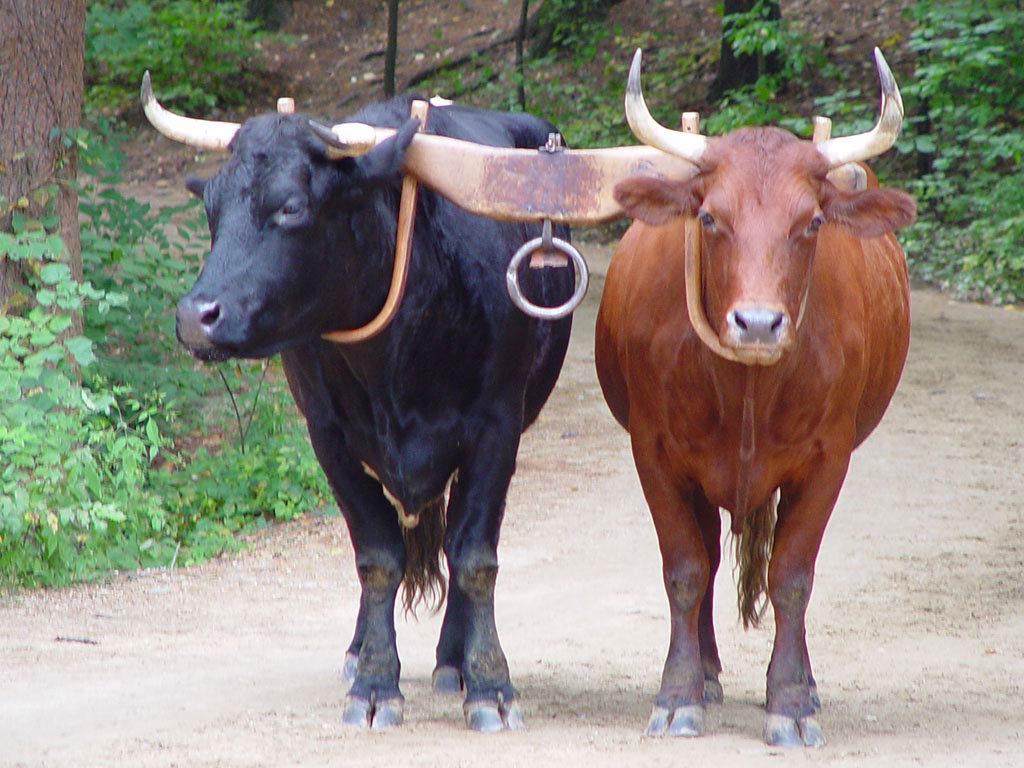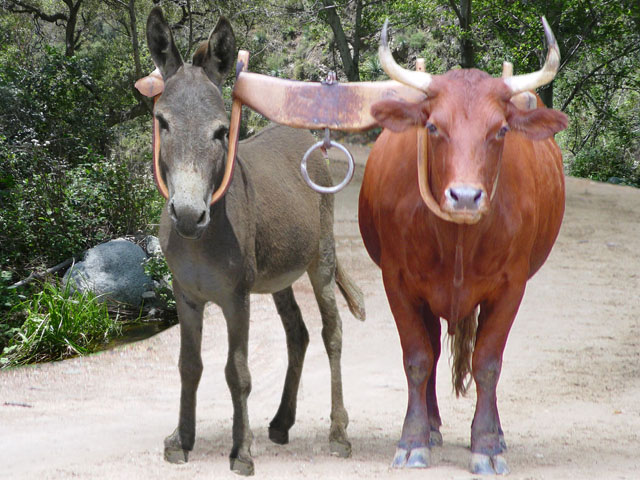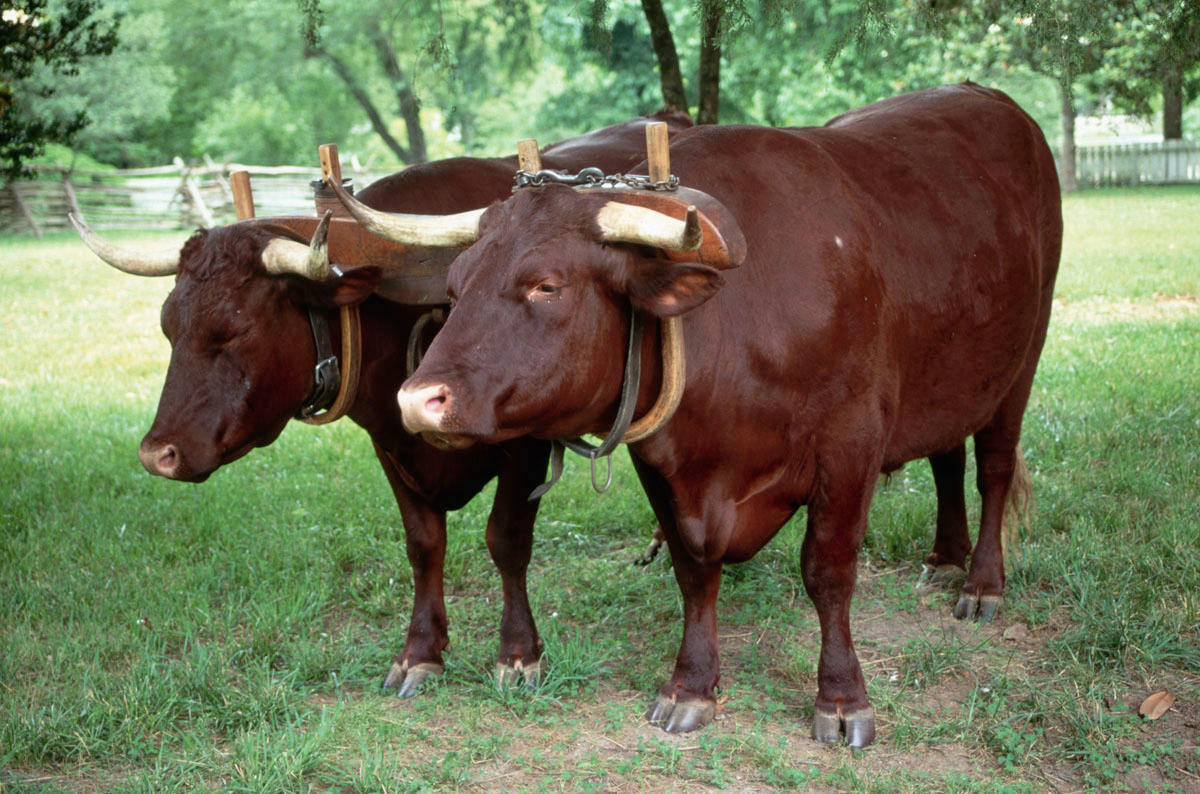The Ox - A Powerful Farm Animal's Role
Have you ever stopped to think about the creatures that have helped humans for a very, very long time? There's one animal, often seen in pictures of old farms, that really stands out. This animal, sometimes called a bullock in places like Australia or India, is a big, strong bovine. It's usually trained to do a lot of work, pulling things and helping out around the farm.
These working animals, you know, are most often male cattle that have grown up and then been castrated. This simple act, you see, changes a lot about them. It helps to calm them down, making them less aggressive. This means they are much safer to be around and to work with, which is pretty important when you're relying on them for big jobs.
So, we're going to take a closer look at this interesting animal. We'll talk about what makes an ox different from other farm animals, like bulls or cows. We'll also explore the many ways people have used them throughout history, and what their lives are like. It's a story, you could say, about a true helper.
Table of Contents
- What Makes an Ox, an Ox?
- How Do We Use the Ox?
- Ox vs. Other Bovines - What's the Difference?
- Where Did the Ox Come From?
What Makes an Ox, an Ox?
When someone mentions an ox, what really comes to mind? Well, basically, an ox is a specific kind of large animal. It's a bovine, which is the general name for animals like cattle. But what makes an ox an ox is its job. These animals are typically trained. They learn to pull heavy things, to carry burdens, and to help people with tasks that need a lot of physical power. So, it's not just any big cow-like creature; it's one that has a very particular role on a farm or in daily life, you know?
More often than not, an ox is an adult male cattle. This means it has reached its full size and has been around for some time. The fact that it's a male animal is important because males usually have more muscle and overall body mass. This makes them really good at tasks that require a lot of brute force. They are, in a way, built for the kind of work they do, which is quite interesting when you think about it.
The term "bullock" is another name you might hear for an ox, especially in places like Great Britain, Australia, or India. So, if you hear someone talking about a bullock, they're probably referring to the same kind of working animal. It's just a different word for it, kind of like how we have different words for the same thing in different regions. This shows, I mean, how widely recognized and used these animals have been across the globe.
The Ox's Gentle Nature
One of the most important things about an ox, especially for those who work with them, is their temperament. You see, oxen are commonly male cattle that have been castrated. This process, which takes away their reproductive organs, has a pretty big effect on them. It stops the production of certain hormones, like testosterone, which are usually linked with aggression and a more feisty spirit in male animals. Without these hormones, the animals tend to be much calmer.
This calmer nature is a huge benefit. When an animal is docile, it means it's easier to manage and less likely to cause trouble. For someone who needs to guide a large animal through fields or along a path, having a creature that is gentle and cooperative is absolutely vital. It makes the work safer for both the person and the animal. So, the castration isn't just a random practice; it's a way to make these powerful animals suitable for working closely with people, which is quite clever, actually.
Think about it: a male cattle that hasn't been castrated, what we call a bull, can be very powerful and, frankly, quite unpredictable. They are bred for different purposes, like reproduction, and their natural instincts can make them difficult to control in a working setting. But an ox, with its more relaxed disposition, can focus on the task at hand. This makes them incredibly reliable partners for tasks that need steady effort and a calm presence, you know? It's all about making them the best they can be for the job.
How Do We Use the Ox?
For a very long time, people have found many ways to put the ox's strength to good use. These animals aren't just for one kind of job; they're quite versatile, actually. One common use, you know, is for riding. While you might not think of riding an ox as often as a horse, they certainly can carry a person. Their broad backs and steady gait make them a reliable way to get from one place to another, especially in areas where other forms of transport might be tricky.
Beyond riding, oxen are also incredibly good at pulling things. They can haul wagons filled with crops, wood, or other goods across long distances. Imagine, if you will, a time before trucks or tractors. The ox was, in a way, the original heavy-duty transport. Their sheer pulling power means they can move loads that a person or even a team of smaller animals might struggle with. This ability to move heavy items has been a cornerstone of farming and trade for many centuries, which is pretty significant.
Moreover, oxen have been used to power machines. This is a bit more advanced than just pulling a wagon. For instance, they can be yoked to a system that helps with irrigation, bringing water to fields that need it. They can also turn large wheels that grind grain, helping to make flour for bread and other foods. These tasks, you see, are essential for survival and for building communities. The ox, therefore, played a part in feeding people and helping civilizations grow, which is quite a big deal.
The Ox's Strength in Work
The core reason for using oxen in all these ways comes down to their impressive physical capabilities. An ox, by its very nature, is a strong creature. It's a male bovine, and these animals are known for their size and muscle. When they are trained for work, their natural power is directed towards specific tasks. This means they can exert a lot of force, which is exactly what's needed for jobs like plowing fields or pulling heavy loads. So, their physical make-up is perfectly suited for a working life, you know?
Plowing is, perhaps, one of the most classic images of an ox at work. Before modern machinery, getting a field ready for planting was a back-breaking job. Oxen, often working in pairs, would pull a plow through the soil, turning it over to prepare it for seeds. This wasn't just about moving dirt; it was about breaking up tough ground, making it fertile and ready to grow food. The steady, consistent power of the ox made this essential task possible, allowing farmers to cultivate larger areas and feed more people, which is pretty fundamental.
Their strength also translates into great endurance. It's not just about being able to pull something once; it's about being able to do it for hours, day after day. Oxen are known for their ability to keep going, to maintain a steady pace even when the work is hard. This reliability means they are a dependable resource for farmers and workers. They don't tire easily, and that consistent effort is what makes them so valuable for long, demanding tasks. It's, like, a testament to their physical makeup and their calm disposition when trained, you know?
Ox vs. Other Bovines - What's the Difference?
It's pretty easy to get confused when talking about different kinds of cattle. You hear terms like "ox," "bull," "cow," "buffalo," and "bison," and they all sound kind of similar. But there are some important distinctions, actually. Knowing these differences helps us understand why each animal is used for particular purposes. So, let's clear up some of that confusion and look at what sets an ox apart from its relatives, because, you know, it's not just about size or color.
First off, it's worth noting that cows, bulls, and oxen all belong to the same general family of cattle. They share a lot of common features, and you can definitely see the family resemblance. However, within this family, there are specific roles and characteristics that make each one unique. They have similarities, sure, but their differences are what really define them and their usefulness to humans. It's a bit like how different members of a human family might have different jobs or hobbies, you could say.
The scientific name for the domestic cattle that an ox comes from is `Bos taurus`. Sometimes, you might see it referred to as `B. Taurus primigenius`. This scientific classification helps us understand that an ox is truly a domesticated form of these large, horned mammals. It's important to remember this because it sets them apart from other big, cow-like animals that might look similar but are actually different species. So, an ox isn't just any big bovine; it's a specific kind, which is quite interesting.
The Ox and the Bull - A Key Distinction
One of the most common questions people have is about the difference between an ox and a bull. It's a really important distinction, actually, because it goes to the heart of what an ox is used for. A bull is an uncastrated male cattle. This means it still has its reproductive organs, and its primary purpose, in many cases, is for breeding. Bulls are often kept to be studs, to help produce more cattle. They can be very powerful, yes, but also, you know, quite spirited and sometimes difficult to manage due to their natural instincts and hormones.
An ox, on the other hand, is a castrated adult male cattle. We've talked about how this castration makes them more docile and easier to work with. This is the key difference. While a bull is focused on reproduction and can be quite aggressive, an ox has been altered specifically to be a working animal. Its energy and strength are channeled into tasks like pulling and carrying, rather than into breeding. This practice makes them much more suitable for the kind of close, consistent work humans need them for, which is pretty practical.
So, you could say, the difference isn't just in their physical state, but in their purpose. Bulls are for making more cattle; oxen are for doing the heavy lifting. This distinction is vital in farming and agriculture. A farmer wouldn't typically use a bull for plowing because of its unpredictable nature, but an ox is perfectly suited for it. It's about, like, fitting the right animal to the right job, and the ox's calm disposition makes it a reliable partner for many kinds of physical labor, you know?
Another point of confusion can be between an ox and animals like bison or buffalo. While they are all large bovines, they are actually distinct species. An ox, as we've discussed, is specifically a castrated male of the domestic cattle species, `Bos taurus`. Bison and buffalo, however, are entirely different kinds of animals with their own unique characteristics and evolutionary paths. So, when you hear "ox," it's not a general term for any big, horned animal; it's quite specific, which is good to remember.
Then there's the cow. A cow is a female cattle. Cows are, of course, incredibly useful for their milk and for producing calves. While they are generally smaller than an ox, cows can still perform many of the same tasks that an ox might do, especially lighter work. They can also be quite useful in many different ways beyond milk and reproduction. Sometimes, you know, they can even be used as a replacement for smaller animals in certain tasks, showing their versatility.
Both cows and oxen are part of the `Bos taurus` species. This means they are essentially the same kind of animal, just different sexes or with different modifications. Their combined products, like milk from cows and meat from both, make up what we call beef. So, while they have different roles on the farm and look a little different, they are very much related. It's, like, a family of animals, each with its own special contribution to human life, which is quite neat, really.
Where Did the Ox Come From?
The story of the ox, you know, is really a part of a much older tale about how humans and animals began to live together. These large horned mammals, the ancestors of our modern oxen, once roamed freely across vast areas. They were, in a way, wild creatures that moved in big groups, especially in places like North America and Europe. It's pretty amazing to think that these powerful animals were once a common sight in landscapes that now look very different.
Over time, however, these wild herds started to disappear from North America and Europe. Their numbers dwindled, and eventually, they were no longer found in the wild in those regions. But, interestingly, some of their wild relatives or descendants still exist in parts of Asia and Africa. So, while they might have vanished from some places, their lineage continued in others. This shows, I mean, how adaptable and resilient these animals are, even in their natural forms.
The ox we know today, the one that works on farms, is a domesticated form of these ancient, wild animals. This means that, many, many years ago, people started to tame them, to bring them into their lives and train them for specific purposes. This process of domestication was a huge step for human civilization. It allowed people to harness the power of these animals, making tasks like farming and transport much easier than they had ever been before. It's a story of partnership, you could say, that has lasted for thousands of years.
The Ox's Place in History
Historically, the word "ox" itself often brings up images of a powerful animal deeply connected to farming and the land. When we think of the past, we often picture these animals pulling plows or helping with other agricultural tasks. This image is, like, pretty accurate because that's exactly what they did. They were the backbone of many early farming communities, providing the muscle needed to cultivate the earth and produce food. It's hard to imagine how some societies would have developed without them, you know?
When people refer to "oxen" (the plural form), it often implies a team of these animals working together. You might picture them yoked in pairs, side by side, pulling a heavy load or a plow. This idea of a team working in unison really highlights their collective strength and their importance in getting big jobs done. One ox is strong, yes, but a team of oxen is truly a force to be reckoned with. They were, in a way, the original heavy machinery, moving things that no single person or even a small group of people could manage on their own.
So, whether it's a single ox or a team of oxen, the core idea remains the same: strength and endurance. These animals have been valued for their ability to perform demanding physical labor consistently over long periods. Their contribution to human culture and economy has been immense, helping to shape how we farm, how we transport goods, and how we build our societies. It's a testament to their enduring usefulness and their quiet, powerful presence throughout history, which is quite remarkable, really.



Detail Author:
- Name : Marcelo O'Hara
- Username : hobart.olson
- Email : erdman.jennie@yahoo.com
- Birthdate : 1993-10-27
- Address : 4147 Leo Vista Ryanburgh, MN 12560-2245
- Phone : 423-467-9641
- Company : Hyatt and Sons
- Job : Government Service Executive
- Bio : Corrupti consequuntur et tempora doloribus. Illo qui eligendi et vitae quisquam earum repudiandae sed.
Socials
facebook:
- url : https://facebook.com/roberto2582
- username : roberto2582
- bio : A cumque ab qui laudantium alias distinctio aliquam numquam.
- followers : 6670
- following : 2589
linkedin:
- url : https://linkedin.com/in/roberto2263
- username : roberto2263
- bio : Laboriosam nihil quasi quis odio dolor explicabo.
- followers : 163
- following : 1463
twitter:
- url : https://twitter.com/roberto3847
- username : roberto3847
- bio : Sequi nostrum vitae quae maiores id corrupti. Nam doloribus eligendi assumenda facere. Nesciunt nam ut et delectus. Quasi in exercitationem nobis hic.
- followers : 4988
- following : 2790